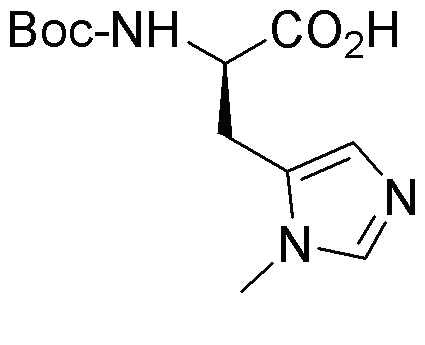Boc-D-His(3-Me)-OH is widely utilized in research focused on:
- Peptide Synthesis: This compound serves as a key building block in the synthesis of peptides, particularly in the development of therapeutic proteins and biologics. Its protective Boc group allows for selective reactions, enhancing the efficiency of peptide assembly.
- Drug Development: In medicinal chemistry, it plays a crucial role in designing new drug candidates, especially those targeting histidine residues in proteins, which are vital for enzyme activity and receptor binding.
- Bioconjugation: The compound is used in bioconjugation processes, facilitating the attachment of biomolecules to drugs or imaging agents, which can improve drug delivery and efficacy in targeted therapies.
- Protein Engineering: Researchers leverage Boc-D-His(3-Me)-OH in protein engineering to modify histidine residues, enhancing protein stability and functionality, which is essential in biopharmaceutical applications.
- Analytical Chemistry: It is utilized in analytical methods for the detection and quantification of histidine-containing compounds, aiding in quality control and research in food and pharmaceutical industries.
General Information
Properties
Safety and Regulations
Applications
Boc-D-His(3-Me)-OH is widely utilized in research focused on:
- Peptide Synthesis: This compound serves as a key building block in the synthesis of peptides, particularly in the development of therapeutic proteins and biologics. Its protective Boc group allows for selective reactions, enhancing the efficiency of peptide assembly.
- Drug Development: In medicinal chemistry, it plays a crucial role in designing new drug candidates, especially those targeting histidine residues in proteins, which are vital for enzyme activity and receptor binding.
- Bioconjugation: The compound is used in bioconjugation processes, facilitating the attachment of biomolecules to drugs or imaging agents, which can improve drug delivery and efficacy in targeted therapies.
- Protein Engineering: Researchers leverage Boc-D-His(3-Me)-OH in protein engineering to modify histidine residues, enhancing protein stability and functionality, which is essential in biopharmaceutical applications.
- Analytical Chemistry: It is utilized in analytical methods for the detection and quantification of histidine-containing compounds, aiding in quality control and research in food and pharmaceutical industries.
Documents
Safety Data Sheets (SDS)
The SDS provides comprehensive safety information on handling, storage, and disposal of the product.
Product Specification (PS)
The PS provides a comprehensive breakdown of the product’s properties, including chemical composition, physical state, purity, and storage requirements. It also details acceptable quality ranges and the product's intended applications.
Certificates of Analysis (COA)
Search for Certificates of Analysis (COA) by entering the products Lot Number. Lot and Batch Numbers can be found on a product’s label following the words ‘Lot’ or ‘Batch’.
*Catalog Number
*Lot Number
Certificates Of Origin (COO)
This COO confirms the country where the product was manufactured, and also details the materials and components used in it and whether it is derived from natural, synthetic, or other specific sources. This certificate may be required for customs, trade, and regulatory compliance.
*Catalog Number
*Lot Number
Safety Data Sheets (SDS)
The SDS provides comprehensive safety information on handling, storage, and disposal of the product.
DownloadProduct Specification (PS)
The PS provides a comprehensive breakdown of the product’s properties, including chemical composition, physical state, purity, and storage requirements. It also details acceptable quality ranges and the product's intended applications.
DownloadCertificates of Analysis (COA)
Search for Certificates of Analysis (COA) by entering the products Lot Number. Lot and Batch Numbers can be found on a product’s label following the words ‘Lot’ or ‘Batch’.
*Catalog Number
*Lot Number
Certificates Of Origin (COO)
This COO confirms the country where the product was manufactured, and also details the materials and components used in it and whether it is derived from natural, synthetic, or other specific sources. This certificate may be required for customs, trade, and regulatory compliance.


